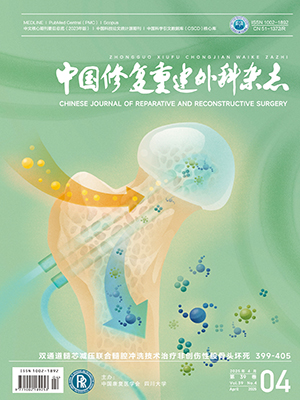Objective To explore the clinical characteristics, clinical classification, and treatment of wrist gouty arthritis. Methods The clinical data of 24 patients with wrist gouty arthritis and complete follow-up between April 2011 and August 2020 were retrospectively analyzed. There were 21 males and 3 females; the first onset age was 21-72 years, with a median age of 50 years. There were 15 cases of simple wrist joint disease, and 9 cases of other joints (hand, knee, ankle, metatarsophalangeal joint) involvement; 19 cases of wrist joint as the first site. Except for 1 patient with a medical history of 21 years, the time from onset to diagnosis in the remaining 23 patients was 7 days to 9 years, with a median time of 2 months. According to the clinical manifestations, imaging manifestations, lesion range, and intraoperative wrist arthroscopy manifestations of wrist gouty arthritis, they were classified into 5 types from mild to severe. Among the 24 patients, 13 were type Ⅰ, 2 were type ⅡA, 3 were type ⅡB, 2 were type ⅢA, 3 were type Ⅳ, and 1 was type Ⅴ. The time from first onset to diagnosis for type Ⅰ and type Ⅱ patients was (12.7±40.1) months, and for type Ⅲ-Ⅴ patients was (152.0± 88.5) months, the difference was significant (t=−4.355, P=0.001). Thirteen patients with type Ⅰ received conservative treatment (including diet, exercise, lifestyle intervention, and medication), and 11 patients with type Ⅱ-Ⅴ received surgical treatment (including 1 case of arthroscopic synovial membrane and gout crystal clearing, 1 case of ligament repair, 5 cases of lesion debridement/artificial bone grafting and filling, 3 cases of wrist fusion, and 1 case of tophicectomy). Before and after treatment, the visual analogue scale (VAS) score was used to evaluate the improvement of wrist joint pain; and the range of motion of the wrist joint (including palmar flexion, dorsal extension, radial deviation, and ulnar deviation) was evaluated. Results Thirteen conservatively treated patients were followed up 10 months to9 years, with an average of 2.2 years. The VAS scores before treatment and at last follow-up were 6.8±0.7 and 2.9±0.9, respectively, and the difference was significant (t=12.309, P=0.000). During follow-up, there was no wrist bone and wrist joint damage; wrist joint range of motion basically reached normal. At last follow-up, the wrist joint palmar flexion, dorsal extension, radial deviation, and ulnar deviation significantly improved when compared with the values before treatment (P<0.05). Eleven surgically treated patients were followed up 5 months to 9 years, with an average of 4.9 years. The swelling and pain of all patients fully relieved, and the VAS scores were 7.3±0.8 before operation, 2.7±0.6 at 1 month after operation, and 2.5±0.6 at last follow-up, which significantly improved after operation (P<0.05); there was no significant difference between 1 month after operation and last follow-up (P>0.05). Excluded 3 patients who underwent wrist fusion, the other 8 patients had significantly improved wrist joint palmar flexion, dorsal extension, radial deviation, and ulnar deviation at last follow-up (P<0.05). The patient’s subjective satisfaction with the surgical results reached 100%. Conclusion A missed diagnosis or misdiagnosis of wrist gouty arthritis will greatly damage the wrist stability and functions. Early and proper interventions can effectively retard the progress of the disease. For the late-stage cases, a staged surgical protocol is recommended.
Citation:
FENG Wei, XIONG Ge. Clinical classification and treatment experience of wrist gouty arthritis. Chinese Journal of Reparative and Reconstructive Surgery, 2021, 35(11): 1411-1416. doi: 10.7507/1002-1892.202103043
Copy
Copyright © the editorial department of Chinese Journal of Reparative and Reconstructive Surgery of West China Medical Publisher. All rights reserved




